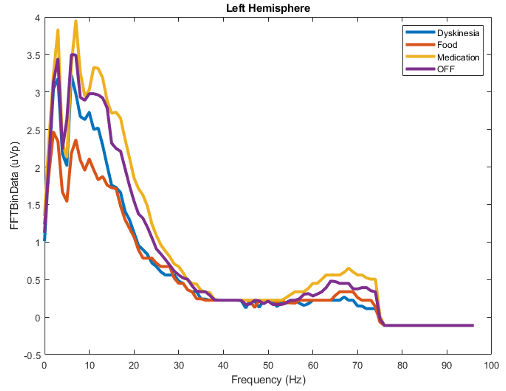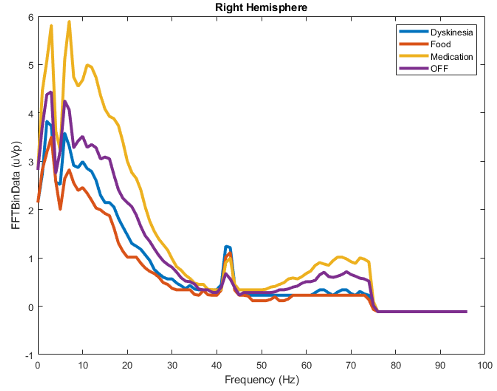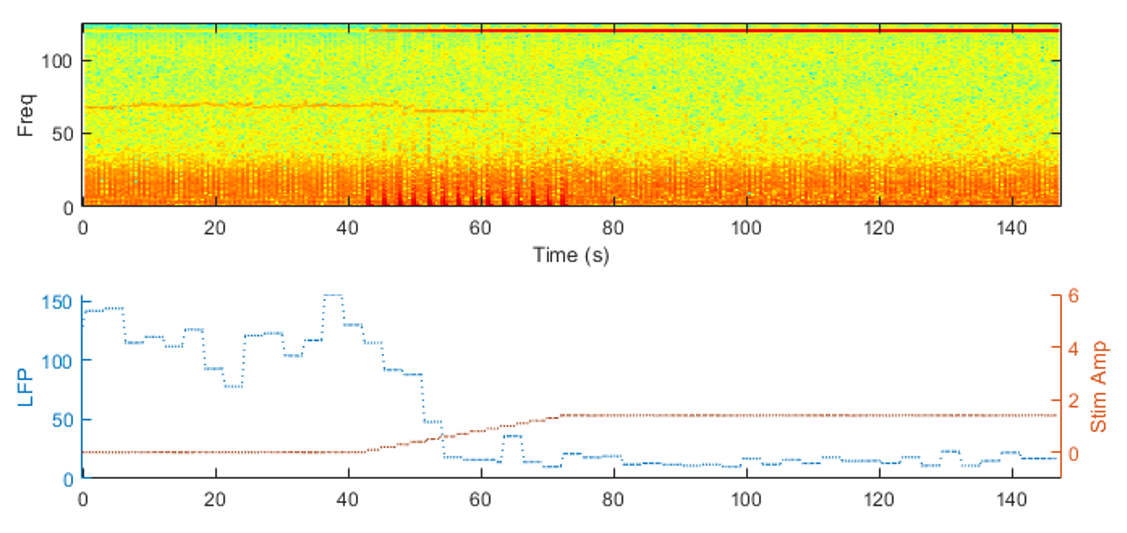Objective: To identify, characterize and treat dyskinesias and off time in a patient with PD via the use of gamma and beta peak LFP using sensing technology.
Background: Symptoms of bradykinesia and rigidity in PD correlate with STN local field potentials in beta oscillation band (13-35Hz)[1]. Both dopaminergic therapy and deep brain stimulation decrease beta band activity which correlates with clinical improvement. Dyskinesia is a hyperkinetic symptom of PD associated with a narrowband gamma oscillation (60-90 Hz)[2]. We used the sensing to optimize severe motor fluctuations in a patient with PD
Method: The present data were obtained from a patient with PD. She underwent bilateral subthalamic DBS surgery for severe on-off dyskinesias. Her symptoms were well controlled for 3 months but she then developed severe off dyskinesias and falls. We then switched to a sensing device to better understand and control her symptoms. LFPs were recorded and reviewed in four subsequent visits over a period of one month. We recorded beta and gamma frequencies and the patient captured events of medication, off time, food and dyskinesia. We also used LFP live streaming in the visits to supplement data analysis. Medication adjustments were made, based on the LFP analysis.
Results: Using the LFP recordings, medication and stimulation was able to be optimized for this patient. Utilizing the in clinic streaming feature the gamma band present in this patient was able to be identified for chronic monitoring. Leveraging the chronic changes in the gamma activity associated with the dyskinesia with medication dosing timing and stimulation levels were adjusted to help minimize the presence of gamma activity and dyskinesia. This case study helps illustrate how valuable having chronic visibility into a patient’s LFPs can play in optimal therapeutic outcomes
Conclusion: Motor fluctuations and biphasic dyskinesias combined with off times are challenging to treat. This case demonstrates the prospect of using novel neurostimulation device that allows continuous recording of LFPs, as a tool to optimize therapy. Understanding the timeline of this patient’s motor fluctuations in parallel to her meals and medication regiment, guided us to confirm the biphasic nature of her dyskinesias and the timing of her off periods and led to medication adjustments with attenuation of her motor fluctuations.
References: [1] Ku¨hn AA, Kupsch A, Schneider GH, Brown P (2006) Reduction in subthalamic 8 –35 Hz oscillatory activity correlates with clinical improvement in Parkinson’s disease. Eur J Neurosci 23:1956 –1960 [2] Nicole C. Swann et Al, Gamma Oscillations in the Hyperkinetic State Detected with Chronic Human Brain Recordings in Parkinson’s Disease. Journal of Neuroscience 15 June 2016, 36 (24) 6445-6458; DOI: https://doi.org/10.1523/JNEUROSCI.1128-16.2016
To cite this abstract in AMA style:
O. Vaou, C. Harrington, S. Stanslaski, R. Cosgrove, A. Depold Hohler. Local Field Potentials (LFP) used to guide treatment of biphasic dyskinesias in a patient with Parkinson’s Disease (PD) [abstract]. Mov Disord. 2021; 36 (suppl 1). https://www.mdsabstracts.org/abstract/local-field-potentials-lfp-used-to-guide-treatment-of-biphasic-dyskinesias-in-a-patient-with-parkinsons-disease-pd/. Accessed December 19, 2025.« Back to MDS Virtual Congress 2021
MDS Abstracts - https://www.mdsabstracts.org/abstract/local-field-potentials-lfp-used-to-guide-treatment-of-biphasic-dyskinesias-in-a-patient-with-parkinsons-disease-pd/



